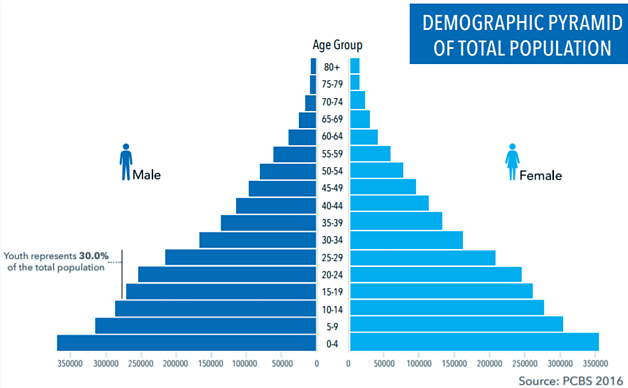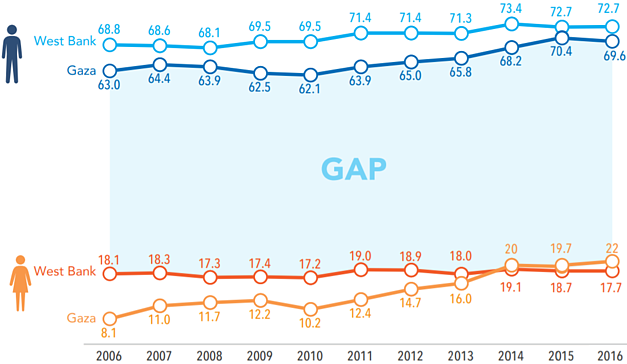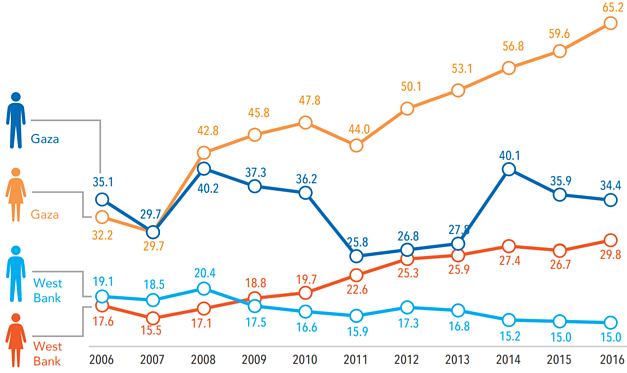Gender analysis and priority gender needs in the occupied Palestinian territory
The humanitarian context in the oPt has a differentiated impact on men, women, boys and girls. Gender analysis assists in identifying groups of the affected population that should be prioritized in the humanitarian response, defining their humanitarian needs based on the differentiated impact, and ensuring gender responsive humanitarian interventions that mitigate negative coping mechanisms prioritizing needs of people with disabilities, divorced or widowed women, adolescent girls and boys, and the elderly. Gender analysis also expands on household level vulnerability from a focus on female-headed households to include also households with high dependency ratios, headed by a person with a disability or a person in detention, married women who are in a separated or polygamous marriage, and widows and divorcees without secure tenure rights.
Over the course of 2017, a number of clusters have made significant efforts to deepen their understanding of gender based vulnerabilities, and ensure a more gender sensitive determination of humanitarian needs. Nonetheless strengthened efforts continue to be needed to improve quality of sex and age-disaggregated data, and to systematically collect information on the impact of gender-based vulnerability using participatory and inclusive needs assessment tools.
Applying the framework for analysis of gender based vulnerabilities, the 2018 HNO identifies the following gender concerns and associated needs based on the differentiated impact of the humanitarian context on men, women, boys and girls, their differentiated access, and differentiated coping mechanisms. In addition to the needs that are briefly outlined in this section, gender analysis has been incorporated throughout the cluster-specific narratives in Annex I, as appropriate.

Gender and Protection concerns
- Protection concerns in connection to the safety, psychosocial wellbeing, denial of rights and access to services (including exposure to harassment at checkpoints) by women and children, continue.
- Higher incidence of intimate partner violence, sexual abuse and forced marriage in communities impacted by conflict, fragmentation and displacement (e.g. IDPs, refugee camps, Gaza, and East Jerusalem), with limited availability and access to multi-sectoral services (i.e. gender-based violence [GBV] case management, health, legal aid and psychosocial support).[1]
- Gaps in legal counselling and assistance with regard to residency rights, especially in East Jerusalem, and family reunification, inheritance and property rights, social rights and access to humanitarian assistance due to the absence of a Palestinian legislative system and the fragmented jurisdiction with regard to women’s rights.
- Gaps in gender and age-differentiated child protection psychosocial support, legal assistance and case management for children with complex protection threats.
- Disability remains a critical source of vulnerability, that can lead to gender based discrimination. Women and girls with disabilities suffer from amplified forms of GBV, and have limited access to services.[2]
- Elderly women are more vulnerable to poverty, disease, and have limited access to services compared to elderly men and the rest of the population. There is no social security system in place to ensure a decent life for the elderly and to provide the different life requirements, such as housing, healthcare, income, disability needs, and food, especially food that reduces the risk of chronic disease. Palestinians are expected to continue to depend on their children in their old age instead of social security, and the burden of the carer role is often placed on the shoulders of women.[3]
- There are gaps in the protection and referrals for school children facing violence in schools and within families or communities. With the experience of conflict, displacement and impoverishment, adolescent boys and girls are especially vulnerable to school dropout and significant protection concerns, including physical and emotional violence, sexual abuse, arrest and detention, child labour, recruitment and use by armed groups, and forced marriage.[4]
Labour force participation*

Gender and food security and livelihoods concerns
- Women in the oPt are particularly disadvantaged with regard to their limited share of agricultural holdings and the limited economic opportunities available for women to generate income. This disadvantage restricts women’s ability to contribute to household food security and also increases the vulnerability of women and female-headed households to food insecurity and malnutrition,[5] with pregnant and lactating women particularly vulnerable to the risks of malnutrition.
- Depleted household resilience is also observed due to high female unemployment, women’s limited access to resources, and concentration of women in economic activities that are directly impacted by protection violations such as herding and harvesting.[6]
- Women farmers’ access to wages, and control over resources provided through humanitarian response, is limited. Humanitarian actors should pay special attention to guaranteeing effective targeting of such assistance.[7]
Unemployment rate by gender and location

65.2 per cent of women in the labour force in Gaza are unemployed. Since 2007 female unemployment in Gaza and West Bank has been increasing and is driving total unemployment rates in oPt upwards, Female unemployment in Gaza is double that in the West Bank. The highest female unemployment rate in the West Bank is in Tulkarm standing at 32 per cent and in Gaza, is in Rafah at 63 per cent (2015 data). Source: PCBS 2017.
Gender and access to basic services
- The general decline in the access of people to basic services (observed in 2017), especially in Gaza in relation to water and electricity, has undermined the ability of women and girls to engage in income generating activities. This is directly linked to the customary division of labour in Palestinian society, where women and girls bear the primary responsibility for the functioning and maintenance of households, which has become more time-consuming. This division of labour continues to apply to married women with disabilities, who face additional hardship.[8]
- Frequent electricity cuts in Gaza have increased women’s vulnerability and stretched households’ coping mechanisms.[9] Power outages have also threatened the life and well-being of vulnerable groups, particularly those needing urgent medical care.[10]
- Increased need for health response to GBV cases (detection, treatment and referral) that is offered through a multi-sectoral approach.[11]
- In some areas, access of children to education is affected by harassment at checkpoints, attacks on schools, and exposure to violence, which increase protection threats and the risk of school dropout, particularly among girls.
- Evidence furthermore points to an increased risk of forced marriage for girls and denial of the right to education in acutely vulnerable communities (particularly in the ARAs in Gaza and Area C in the West Bank).
- Displacement, vulnerable localities (those particularly affected by Israeli practices and policies) and poor conditions increase the vulnerability of women and children. Women who have partial or no tenure are especially vulnerable in securing their shelter needs (such as women heads of households, separated, divorced or abandoned women, women victims of GBV, and widows).[12]
- Limited access to drinking water, domestic use water and wastewater and solid waste management in the Gaza Strip, Area C and East Jerusalem have significant impact on household spending, health and hygiene, and school attendance. Inadequate WASH facilities expose women and girls to threats and burdens associated with meeting their personal hygiene needs, undertaking basic domestic chores, managing household water needs, and securing the needs of children, people with disabilities, the elderly and the chronically ill.[13]
- The trend of increased denial of access for patients applying for Israeli permits to exit Gaza for medical purposes is leading to the suffering of many patients, including women and children.[14]
Gender and resilience
Access to income, food, services and assets are amongst the key components of resilience. Women in the oPt are particularly disadvantaged with regard to these components given their limited share of agricultural holdings, their restricted access to services, and the limited economic opportunities available for women to generate income. This disadvantage restricts women’s ability to contribute to household resilience and food security, and also increases the vulnerability of women and female-headed households to food insecurity and malnutrition.
Gender and community engagement
According to a recent study by the Shelter and NFIs Cluster,[15] limited knowledge within vulnerable groups such as widows, women heads of households, and women with disabilities, of the services offered by different humanitarian actors and the terms and criteria for receiving assistance often results in unequal access to these services, and ultimately to humanitarian responses that fail to consider age, gender and location.
[1] UN Women-OCHA Factsheet “The Gaza Strip: The long-term impact of the 2014 hostilities on women and girls, December, 2015”.
[2] UNFPA: GBV Mapping (2016); UN Women: Navigating Through Shattered Paths: NGO Service Providers and Women Survivors of Gender-based Violence. An Assessment of GBV Services in Gaza. 2017, to be published.
[3] UN Women-OCHA Factsheet “The Gaza Strip: The long-term impact of the 2014 hostilities on women and girls, December, 2015”. According to a research conducted by the Women’s Affairs Centre in 2016 in Gaza, 59 per cent of the research respondents (total of 988 women with disabilities) have suffered of one form of violence, 31 per cent have reported being subjected to neglect and house confinement, 23.8 per cent were denied the right to get married and start a family. While confronted with many legal and psychosocial challenges, 91 per cent of the respondents had never received legal services and 33.9 per cent believed that the availability of psychosocial support was limited. A 2016 study by YMCA in the West Bank revealed that 39 per cent of the women with disabilities (respondents) were abused, out of which 37 per cent was domestic abuse, 34 per cent community abuse, and 28 per cent abuse by the Occupation. Physical abuse accounted for 49 per cent, while emotional abuse accounted for 81 per cent.
[4] UN Women: Building Ties: Towards Integrated Strategies & Policies for Empowering Palestinian Women, 2014.
[5] UN Women-OCHA Factsheet “The Gaza Strip: The long-term impact of the 2014 hostilities on women and girls, December, 2015”.
[6] SEFSec 2014
[7] UN Women-OCHA Factsheet “The Gaza Strip: The long-term impact of the 2014 hostilities on women and girls, December, 2015”.
[8] UN Women - UN OCHA: Needs of women and girls in humanitarian action in Gaza: Gender Alert for the 2016 Response Plan.
[9] Ibid.
[10] GBV Sub-Cluster: The Humanitarian Impact of Gaza’s Electricity and Fuel Crisis on Gender-based Violence and services, 2017.
[11] OCHA: Protection of Civilians Weekly Report, 18 - 31 July 2017.
[12] UN Women: Navigating Through Shattered Paths: NGO Service Providers and Women Survivors of Gender-based Violence. An Assessment of GBV Services in Gaza. 2017, to be published.
[13] UN Women - UN OCHA: Needs of women and girls in humanitarian action in Gaza: Gender Alert for the 2016 Response Plan.
[14] WASH Cluster Gender Toolkit (2017).









